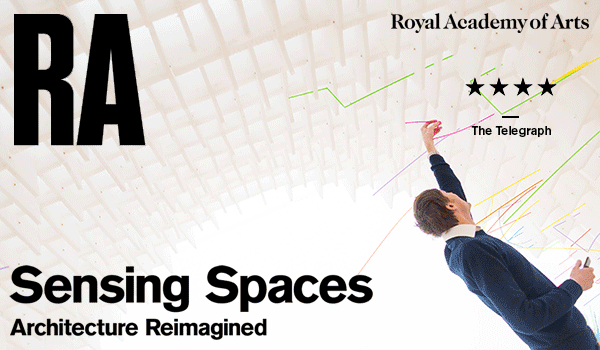30 March 2014
Sensing Spaces at the Royal Academy
Architecture is a long-term interest of mine though this is entirely as a consumer and I would not claim any expertise in the technicalities of the work, e.g. how stresses are calculated or joints designed. Basically I like looking at interesting buildings and getting to see inside them if I can.
And so it was only going to be a short matter of time before I went to see Sensing Spaces at the Royal Academy.
Sensing Spaces was a collection of very different spaces spread across the RA's main exhibition rooms.
In concept and execution it was something like Architects Build in Small Spaces that was on at the V&A in 2010, which I loved.
The first construct was a platform supported by four cylindrical legs which also acted as staircases (two up and two down to avoid conflict).
The crispness of the wood was a real pleasure and the children loved the peep-holes in the walls.
Having climbed up one of the staircases I then discovered that there was another way up/down, a very gentle ramp hidden by a floor to ceiling wall made from the same wood.
I would love to have this in my garden. I'm sure I could make the logistics work out somehow.
In two dark rooms there were spot lights on the floor with fibre-optics cables leading from them to make 3-dimensional patterns of light. The arrangements of lights and the cables were both curved so the patterns they made shifted as I walked around the installations.
The most successful space, at least for the children but not just them,
It was a tunnel made out of some sort of plastic that had a grid of holes in it which visitors were asked to push long coloured straws in to.
I did my bit, I felt a moral obligation to do so, and pushed a few single straws in. Most people were more adventurous and twisted and platted the straws in to interesting shapes before attaching them to the tunnel.
Others decided to keep the interesting things they had made and to take them home with them.
Others missed the point of the exhibition entirely, and the polite notices, and decided that it would be better to take a bundle of fresh straws home and to make something out of them there.
The tunnel part of the exhibition fooled me and it took a while after I walked through it to realise that I had emerged in to a separate room.
The same trick was played in the next construct.
The first part was a series of corridors with walls made out of neat sticks and floors of illuminated glass.
The corridors were something of a maze and there were even a couple of side rooms to hide in.
The crunching sound that pulled me through the maze came from the final room which had a pebbled floor and a mirror along one wall. Most people took photos of themselves, and so did I. That's me in the corner holding a camera at an odd angle.
The combination of sticks, pebbles and mirror worked well and I had a few happy minutes crunching around and enjoying the space before moving on to the next rooms.
The last two rooms that I went to (the rooms could be visited in any order, I just chose to go clockwise) contrasted light and dark.
Of course the human eye, and the camera, easily adjust to different lights and so I had to move between the two rooms a few times to get the impact. This was rather like the coloured rooms in Light Show at the Hayward Gallery.
The lighting of the two rooms was reinforced by the shaped ceilings, that's light at the top and dark below it on the right.
There were some other things to see but these were the main attractions and after seeing them all once I went around all the rooms again to take even more photos.
The use of different materials and shapes made the exhibition a series of distinct experiences and my reaction to these were mixed. I loved the platform and the maze (perhaps it was because of the wood that they were both made out of), found the curved lights and the light/dark rooms interesting but the straws did little for me other than the childish pleasure of playing with the straws.
Overall it was an stimulating event and that was largely because it was possibly to interact directly with all of the pieces rather than, say, looking at drawings or models of them. And that is clearly the best way to see whether spaces work.
More stories like this:
architecture,
exhibition,
royal_academy
Subscribe to:
Post Comments (Atom)















No comments:
Post a Comment
All comments are welcome. Comments are moderated only to keep out the spammers and all valid comments are published, even those that I disagree with!